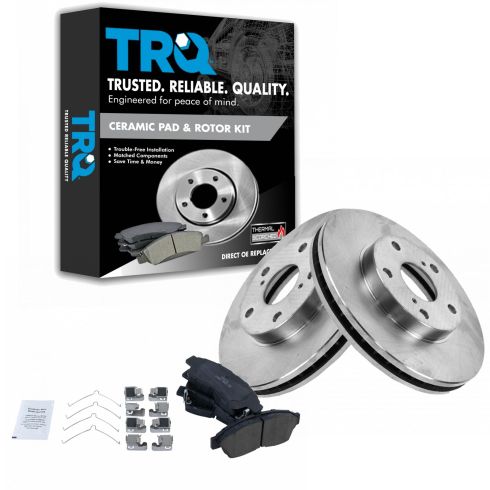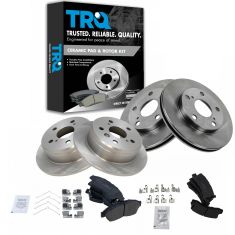1ABFS00361-Toyota Camry Front Ceramic Brake Pad & Rotor Kit TRQ BKA10606

Replaces
1992 Toyota Camry L4 2.2L Front Ceramic Brake Pad & Rotor Kit TRQ BKA10606

Product Reviews
Loading reviews
4.79/ 5.0
29
29 reviews
Good value
October 13, 2017
Received the kit in a timely manner. Instillation was straightforward. Have put about 200 miles on them so far and no problems. Very quiet, with the ceramic pads.
front pads and rotors
January 9, 2018
worked fine. fair price l wish they were not from china.
Parts for my car
September 22, 2018
I ordered parts for my car they came very quickly I had an issue with some of the stuff I ordered they issued a very quick refund I also ordered new parts and I had the part the next day free shipping is nice A very good company for online parts.
Works like I need them to.
October 24, 2018
Everything was affordable and good. Break change was standard. Would be 5 stars if they included the spray to remove the wax/oils on the rotors without increasing the price, but still really great.
June 25, 2019
Great service and great parts
Squeak
October 14, 2019
Still squeaks after less than a month
Quality
October 20, 2019
Cant beat the price on these quality brakes. Fast shipping
October 25, 2019
Good so far and fast service
Good Quality at a fare price
January 7, 2020
I recommend rotors and pads from 1aAuto they have good quality parts at a good price
great deal and great parts and would grately recomend this product
March 18, 2020
have been dealing with 1a auto of and on the past couple of years and out of all of online sites i have ordered from this is the only site that i get exactly what i ordered in reasonable amount of time with just standard shipping. I would recommend 1aauto to anyone for parts.
Perfect and as advertised
April 2, 2020
Due to being burned by another website, I was worried but bought this kit anyways. I AM GLAD I DID! Perfect fit and new in box as ordered. I'm glad I did order as now 1aauto.com is my go-to for parts for my older vehicles.
Brakes were perfect
August 8, 2020
Outstanding
First Time - DIY Brake job
September 22, 2020
Ordered this Kit for my 98 Camry with hesitation not having done something like this before. Watching videos from 1A Auto on how to do the job provided good insight and confidence - they were very helpful. The kit arrived in time for the Labor Day weekend.
All the parts were present - including sufficient amount of grease to complete the job. The parts were the right size, and the step by step video instructions online were superb.
Did not end up installing the rotors as the old ones seemed smooth and in good shape. So now I have new rotors sitting around. But the net cost of the project is easily 1/3 of what it would cost at an auto shop.
I highly recommend 1AAuto - I would recommend the product. Make sure you really do need the Rotors before ordering the full kit. I would have saved some money if I just ordered the brake pad kit without the rotors. But that is on me - not the fault of 1AAuto.
Theyre working great!
June 14, 2021
Fit perfectly and theyve been working great!
Excellent product!
August 2, 2021
Very pleased with the product. Arrived quickly and matched existing perfectly.
Break pad and rotor
September 27, 2021
it was on time delivery and this parts are perfect match with my 97 Camry! Also it eliminates my front wheels wiggling during breaking on high speed.
May 23, 2022
Everything fit like a glove. Its all in working order. The video definitely helped out. I will be buying from here the next time I need new brakes. My order also shipped really quick.
Good product
June 22, 2022
Good product. Pads fit tightly in remanufactured brake caliper units that I needed to purchase locally. Would buy again.
Very nice product with all accessories
September 11, 2022
The brakes look great and they perform great! I had some shaky steering wheel symptoms when braking, before I replaced them. Now it's very responsive and smooth deceleration.
Excellent products
November 14, 2022
Great customer service
For grandsons car.
January 3, 2023
I got this for my grandsons car. He is very happy with having brakes that work great. Quick shipping.
Excellent Quality
February 25, 2023
Great quality, before I replace the calipers my old ones were freezing a lot and the driver side was pulling me to the left, after replace with the new one I have no issue at all.
High quality pads and rotors
March 14, 2023
Parts fit and perform great, I recommend these parts
April 30, 2023
Great quality and inexpensive compared to autozone and the other auto part stores
May 7, 2023
Look and drive good
October 2, 2023
Fit perfectly on my '98 camry with no issues.
Bolts rite up like OEM
February 8, 2024
The thing I love about anything A1 shipping is always fast and their parts fit just like OEM, you really can't beat 1A .
Good brakes but Noisy
April 29, 2024
The brakes fit well and work well, but they were noisy right away and it took over 100 miles of driving to get them broke in to where they were not making noise driving. Did not have a dust shield rubbing or anything like that making the noise, it was the pads. They do seem to be good parts so far, they just have a rough finish which causes them to make the noise until they are broke in.
Good parts
July 25, 2024
Good parts, easily assembled.
Customer Q&A
Is this rotor 275mm for a 14 " tire?
September 26, 2017
10
The original wheels on this car were 14". The bolt pattern is 5 on 114.3mm (5-5/8").
September 27, 2017
Michael C
10
Yes
February 23, 2019
D R
10
I used it on my 98 camry which has 14inch tires.
September 22, 2020
V I
Toyota is a registered trademark of Toyota Motor Corporation. 1A Auto is not affiliated with or sponsored by Toyota or Toyota Motor Corporation.
See all trademarks.













